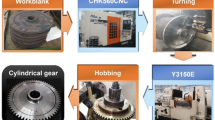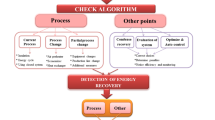Abstract
Energy performance improvement is a basic significant way of addressing both energy security and environment concerns, which can promote energy-saving and emission-reduction. There are various measures of energy performance, with different purposes and applications. However, there are few models or approaches for measuring and quantifying energy saving potential in machining systems. To better perform the energy performance analysis and evaluating energy saving potential in machining, an energy performance evaluation method based on energy benchmark in machining systems is addressed. Energy performance characteristics is analysed, and some energy performance concepts and indicators are proposed. The energy performance evaluation based on energy benchmark is developed for machining systems. Furthermore, a case study involving the establishment of an energy performance evaluation and energy saving potential for gears in a real machining plant was examined, illustrating the practicability of the proposed method.







Similar content being viewed by others
References
Cai, W., Li, L., Jia, S., et al. (2020). Task-oriented energy benchmark of machining systems for energy-efficient production[J]. International Journal of Precision Engineering and Manufacturing-Green Technology, 7(1), 205–218.
Chen, G. Q., Wu, X. D., Guo, J., et al. (2019). Global overview for energy use of the world economy: Household-consumption-based accounting based on the world input-output database (WIOD). Energy Economics, 81, 835.
Duflou, J., Sutherland, J., Dornfeld, D., et al. (2012). Towards energy and resource efficient manufacturing: A processes and systems approach. CIRP Annals -Manufacturing Technology, 61(2), 687–609.
IEA (International Energy Agency), Energy efficiency (2017). IEA World Energy Statistics and Balances (database), OECD/IEA, Paris, www.iea.org/statistics/relateddatabases/worldenergystatisticsandbalances/
IEA (2017c), Mobility Model (database), (2017). OECD/IEA, Paris, www.iea.org/etp/etpmodel/transport/ (accessed 25 May 2017).
IEA (2017d), Energy Technology Perspectives, (2017). (Residential Model), OECD/IEA, Paris, www.iea.org/etp/.
Ke, J., Price, L., McNeil, M., et al. (2013). Analysis and practices of energy benchmarking for industry from the perspective of systems engineering. Energy, 54, 32–44.
Hu, L., Cai, W., Shu, L., et al. (2021). Energy optimisation for end face turning with variable material removal rate considering the spindle speed changes. International Journal of Precision Engineering and Manufacturing-Green Technology, 8(2), 625–638.
Liang, C., Feng, H., & Chun, L. (2014). Energy efficiency benchmarking of energy-intensive industries in Taiwan. Energy Conversion and Management, 77, 216–220.
S, Turetskyy A, Loellhoeffel T, , et al. (2020). Machine learning approach for systematic analysis of energy efficiency potentials in manufacturing processes: A case of battery production. CIRP Annals -Manufacturing Technology, 69(1), 21–24.
ISO 14955–1:2014. (2014). Machine tools e environmental evaluation of machine tools -part 1: design methodology for energy-efficient machine tools. International Organization for Standardization (ISO).
European Union. Directive 2012/27/EU of the european parliament and of the council of 25 October 2012 on energy efficiency, amending directives 2009/ 125/EC and 2010/30/EU and repealing directives 2004/8/EC and 2006/32/EC.2012 [accessed: 12.05.2015] Available: http://eur-lex.europa.eu/LexUriServ/LexUriServ.do? uri¼OJ:L:2012:315:0001:0056:EN:PDF
JIS TS B 0024–1:2010. (2010). Machine tools – test methods for electric power consumption – part 1: machining centres. Japanese Standards Association
Industrial Assessment Centers (IAC). Energy Efficiency & Renewable Energy of U.S. DOE [EB/OL] <http://iac.rutgers.edu/about.php>; 2012–06–04
European Commission. EUROPE (2020). a strategy for smart, sustainable and inclusive growth; 2010. http://ec.europa.eu/europe2020/index_en.htm
National technical committee on energy fundamentals and management of standardization administration of China. (2013). GB/T12723-2008 General principles for establishing allowance of energy consumption per unit throughput. Beijing: Standards Press of China.
Roedger, B. J., Schoenemann, M., et al. (2020). Combining life cycle assessment and manufacturing system simulation: evaluating dynamic impacts from renewable energy supply on product-specific environmental footprints. International Journal of Precision Engineering and Manufacturing-Green Technology. https://doi.org/10.1007/s40684-020-00229-z
Shi, X. (2014). Setting effective mandatory energy efficiency standards and labelling regulations: A review of best ractices in the Asia Pacific region. Applied Energy, 133, 135–143.
Guo, Y., Duflou, J., Deng, Y., et al. (2018). A life cycle energy analysis integrated process planning approach to foster the sustainability of discrete part manufacturing. Energy, 153, 604–617.
Reddy, B. S. (2013). Barriers and drivers to energy efficiency–A new taxonomical approach. Energy Conversion and Management, 74, 403–416.
IPCC (Intergovernmental Panel on Climate Change). Contribution of Working Group III to the Third Assessment Report of the Intergovernmental Panel on Climate Change. Chapter 5. Barriers, Opportunities, and Market Potential of Technologies and Practices. Retrieved on October 30, 2008 fromhttp://www.grida.no/publications/other/ipcc_tar/?src=/climate/ipcc_tar/wg3/index.htm
Leiden, A., Herrmann, C., & Thiede, S. (2020). Cyber-physical production system approach for energy and resource efficient planning and operation of plating process chains. Journal of Cleaner Production, 280, 125160.
Kara, S., & Li, W. (2011). Unit process energy consumption models for material removal processes. CIRP Annals Manufacturing Technology, 60(1), 37–40.
Bunse, K., Vodicka, M., Schönsleben, P., et al. (2011). Integrating energy efficiency performance in production management–gap analysis between industrial needs and scientific literature. Journal of Cleaner Production, 19(6), 667–679.
de Groot, H., Verhoef, E., & Nijkamp, P. (2001). Energy saving by firms: Decision-making, barriers and policies. Energy Economics, 23(6), 717–740.
Worrell, E., Bernstein, L., Roy, J., et al. (2009). Industrial energy efficiency and climate change mitigation. Energy efficiency, 2(2), 109.
Lo, K. (2014). A critical review of China’s rapidly developing renewable energy and energy efficiency policies. Renewable and Sustainable Energy Reviews, 29, 508–516.
Wang, Q., Zhao, Z., Zhou, P., et al. (2013). Energy efficiency and production technology heterogeneity in China: A meta-frontier DEA approach. Economic Modelling, 35, 283–289.
Lin, B., & Du, K. (2013). Technology gap and China’s regional energy efficiency: A parametric metafrontier approach. Energy Economics, 40, 529–536.
Lin, B., & Du, K. (2014). Measuring energy efficiency under heterogeneous technologies using a latent class stochastic frontier approach: An application to Chinese energy economy. Energy, 76, 884–890.
Taylan, O., Kaya, D., & Demirbas, A. (2016). An integrated multi attribute decision model for energy efficiency processes in petrochemical industry applying fuzzy set theory. Energy Conversion and Management, 117, 501–512.
Zhu, Q., Lujia, F., Mayyas, A., et al. (2015). Production energy optimization using low dynamic programming, a decision support tool for sustainable manufacturing. Journal of Cleaner Production, 105, 178–183.
May, G., Barletta, I., Stahl, B., et al. (2015). Energy management in production: A novel method to develop key performance indicators for improving energy efficiency. Applied Energy, 149, 46–61.
US EPA. ENERGY STAR – the power to protect the environment through energy efficiency. US Environmental Protection Agency; Washington, DC; 2003
Dietmair, A., Verl, A., & Eberspaecher, P. (2011). Model based energy consumption optimisation in manufacturing system and machine control. International Journal of Manufacturing Research, 6(4), 380–401.
Boyd, G., Dutrow, E., & Tunnessen, W. (2008). The evolution of the ‘“energy star”’ energy performance indicator for benchmarking industrial plant manufacturing energy use. Journal of Cleaner Production, 16(6), 709–715.
Zhou, X., Liu, F., & Cai, W. (2016). An energy-consumption model for establishing energy-consumption allowance of a workpiece in a machining system. Journal of Cleaner Production, 135, 1580–1590.
Cai, W., Liu, F., Xie, J., et al. (2017). A tool for assessing the energy demand and efficiency of machining systems: Energy benchmarking. Energy, 138, 332–347.
Cai, W., Liu, F., Zhang, H., et al. (2017). Development of dynamic energy benchmark for mass production in machining systems for energy management and energy-efficiency improvement. Applied Energy, 202, 715–725.
Park, C. W., Kwon, K. S., Kim, W. B., et al. (2009). Energy consumption reduction technology in manufacturing—A selective review of policies, standards, and research. International Journal of Precision Engineering and Manufacturing, 10(5), 151–173.
Wang, Q., Liu, F., & Li, C. (2013). An integrated method for assessing the energy efficiency of machining workshop. Journal of Cleaner Production, 52, 122–133.
Gao, M., Li, L., Wang, Q., et al. (2020). Energy efficiency and dynamic analysis of a novel hydraulic system with double actuator. International Journal of Precision Engineering and Manufacturing-Green Technology, 1, 1–13.
Yoon, H. S., Kim, E. S., Kim, M. S., et al. (2015). Towards greener machine tools–A review on energy saving strategies and technologies. Renewable and Sustainable Energy Reviews, 48, 870–891.
Acknowledgements
This work was supported in part by the Chongqing Research Program of Basic Research and Frontier Technology (Grant No. cstc2020jcyj-bsh0029), the Hong Kong Scholars Program (Grant No. XJ2019059), the National Natural Science Foundation of China (Grant No. 71971130, 51705055, 51875480), and the Science and Technology Research Program of Chongqing Municipal Education Commission (Grant No. KJZD-K201903401).
Author information
Authors and Affiliations
Corresponding author
Additional information
Publisher's Note
Springer Nature remains neutral with regard to jurisdictional claims in published maps and institutional affiliations.
Rights and permissions
About this article
Cite this article
Cai, W., Zhang, Y., Xie, J. et al. Energy Performance Evaluation Method for Machining Systems Towards Energy Saving and Emission Reduction. Int. J. of Precis. Eng. and Manuf.-Green Tech. 9, 633–644 (2022). https://doi.org/10.1007/s40684-021-00365-0
Received:
Revised:
Accepted:
Published:
Issue Date:
DOI: https://doi.org/10.1007/s40684-021-00365-0




